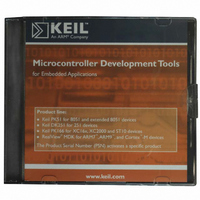MDK-ARM Keil, MDK-ARM Datasheet - Page 83

MDK-ARM
Manufacturer Part Number
MDK-ARM
Description
KIT REALVIEW MCU DEVELOPMENT
Manufacturer
Keil
Type
Compiler and IDEr
Specifications of MDK-ARM
For Use With/related Products
ARM MCUs
Lead Free Status / RoHS Status
Lead free / RoHS Compliant
- Current page: 83 of 156
- Download datasheet (3Mb)
Getting Started: Building Applications with RL-ARM
An HTML file that is intended to output a dynamically changing greeting
message to the web browser would look like this:
t
t
c a
t
t
.
The first two lines begin with the “t” script command. This means that the
remainder of the line is HTML and will be sent to the client browser. The third
line begins with the “c” script command. This means it is a command line. The
remainder of the line will be passed in an environment variable to the common
gateway interface function cgi_func(). The environment variable is called env
and from the example above it will contain the string “a <p>%s</p>”. The
start of this string consists of user defined control characters, in this case the “a”.
The cgi_func() must contain code to parse these characters and then format the
remainder of the HTML line.
U16 cgi_func (U8 *env, U8 *buf, U16 buflen, U32 *pcgi)
}
In the case above when the page is loaded, the “a” clause of the switch statement
will be executed. The sprint() statement then becomes
len = sprintf ((S8 *) buf, <p>%s</p> , "Hello World");
and the contents of buf becomes:
<p> Hello World </p>
which is then output to the browser.
To the browser the HTML code will appear as shown below.
<HTML><HEAD><TITLE>Hello World</TITLE></HEAD>
<BODY>
<H2 ALIGN=CENTER>Output a Greeting as Dynamic HTML</H2>
<p> Hello World </p>
</BODY>
switch (env [0])
}
return ((U16) len);
case 'a':
len = sprintf ((S8 *) buf, (const S8 *) &env [2], "Hello World");
break;
<HTML><HEAD><TITLE> Hello World Example </TITLE></HEAD>
<H2 ALIGN=CENTER> Output a Greeting as Dynamic HTML </H2>
<p> %s </p>
</BODY>
</HTML>
{
# The period marks the end of the file
{
83
Related parts for MDK-ARM
Image
Part Number
Description
Manufacturer
Datasheet
Request
R

Part Number:
Description:
KIT REALVIEW MCU DEVELOPMENT
Manufacturer:
Keil
Datasheet:

Part Number:
Description:
Development Software SUPPORT EXTENSION FOR MDK-ARM-B
Manufacturer:
Keil Software

Part Number:
Description:
Development Software SUPPORT EXTENSION FOR MDK-ARM
Manufacturer:
Keil Software

Part Number:
Description:
KIT REALVIEW MCU DEVELOPMENT
Manufacturer:
Keil
Datasheet:

Part Number:
Description:
Development Software MCU DEV KIT FOR ARM UPG TO FLOATING LIC
Manufacturer:
Keil Tools

Part Number:
Description:
Development Software MCU DEV KIT FOR ARM W/ FLOATING LICENSE
Manufacturer:
Keil Software

Part Number:
Description:
Development Software MCU DEV KIT FOR ARM uVISION & C++ & RTX
Manufacturer:
Keil Tools

Part Number:
Description:
Development Software SUPP LICENSE RENEWAL 90+ DAYS NO TECH SUP
Manufacturer:
Keil Software
Part Number:
Description:
KEIL C-COMPILER INTERNATIONAL
Manufacturer:
Silicon Laboratories Inc

Part Number:
Description:
BOARD EVAL FOR LPC213X ARM MCU
Manufacturer:
NXP Semiconductors
Datasheet:
Part Number:
Description:
K60N512 Keil Tower Kit
Manufacturer:
Freescale Semiconductor
Datasheet:










